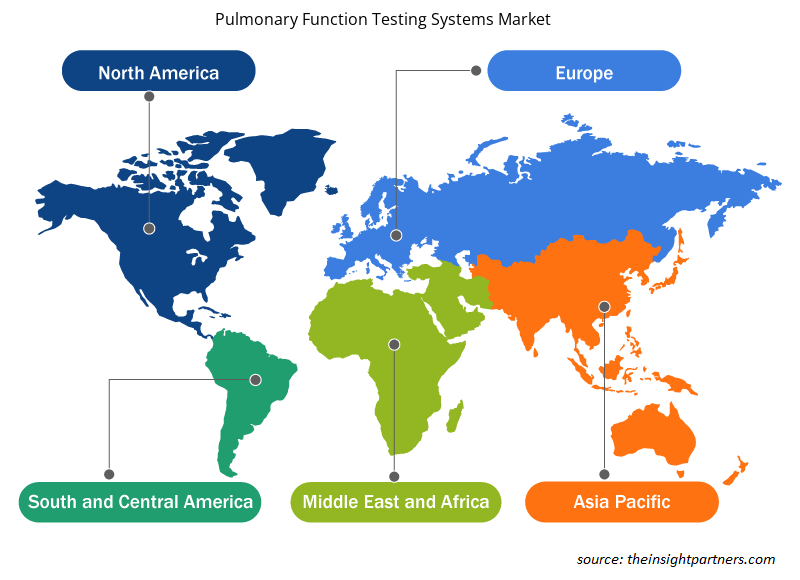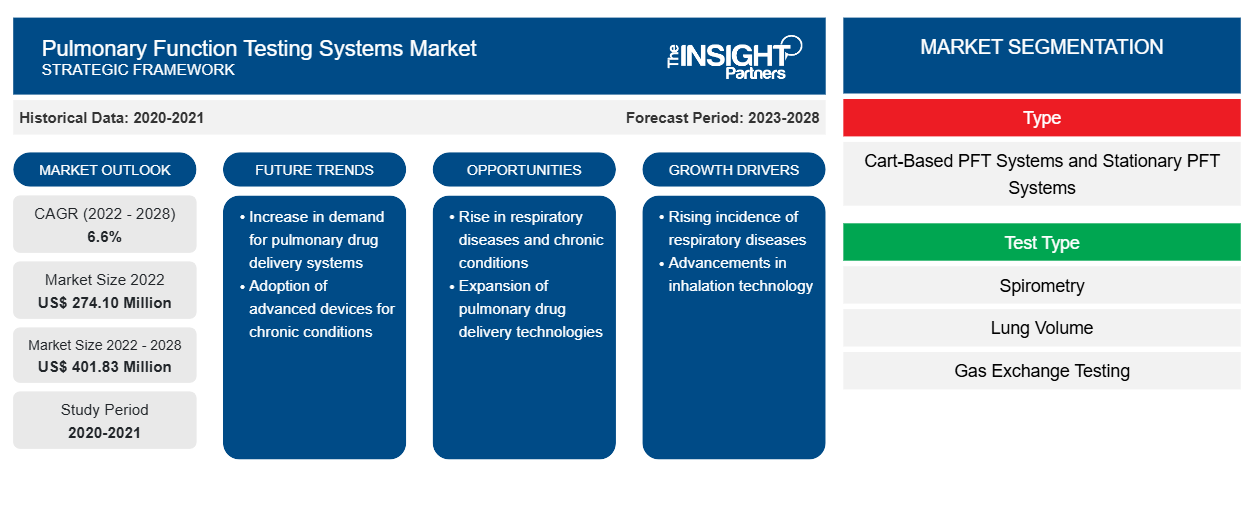Es wird erwartet, dass das Marktvolumen für Lungenfunktionstestsysteme von 274,10 Millionen US-Dollar im Jahr 2022 auf 401,83 Millionen US-Dollar im Jahr 2028 ansteigt. Der Markt für Lungenfunktionstestsysteme wird voraussichtlich von 2022 bis 2028 eine durchschnittliche jährliche Wachstumsrate (CAGR) von 6,6 % verzeichnen.
Lungenfunktionstests (PFT) sind eine Reihe nichtinvasiver Tests, mit denen gemessen wird, wie gut die Lunge eines Patienten funktioniert. Diese Tests sind wichtig für die Diagnose und Behandlung von Patienten mit Atemwegserkrankungen. Um die Tests durchzuführen und genaue Ergebnisse zu erhalten, ist es wichtig, die richtigen PFT-Geräte und -Maschinen zu verwenden. Das Lungenfunktionstestsystem besteht aus mehreren Geräten, mit denen verschiedene Aspekte der Lungenfunktion gemessen werden. Dazu kann gehören, wie gut die Lunge Luft aufnimmt und ausstößt, wie effizient sie Sauerstoff ins Blut überträgt und wie viel Luft sie aufnehmen kann. PFTs messen Lungenvolumen, Lungenkapazität und die Menge des Gasaustauschs. Die steigende Inzidenz von Lungenerkrankungen und berufsbedingten Lungenerkrankungen trägt zum wachsenden Markt für Lungenfunktionstestsysteme bei . Das Risiko einer Kreuzkontamination und der Mangel an qualifiziertem Fachpersonal hemmen jedoch das Marktwachstum.
Der Markt für Lungenfunktionstestsysteme wurde nach Typ, Testtyp, Komponente, Anwendung, Endbenutzer und Geografie segmentiert. Geografisch ist der Markt hauptsächlich in Nordamerika, Europa, Asien-Pazifik, den Nahen Osten und Afrika sowie Süd- und Mittelamerika segmentiert. Der Bericht bietet Einblicke und eine eingehende Analyse des Marktes und betont Parameter wie Markttrends für Lungenfunktionstestsysteme, technologische Fortschritte, Marktdynamik und die Wettbewerbslandschaftsanalyse führender Marktteilnehmer.
Passen Sie diesen Bericht Ihren Anforderungen an
Sie erhalten kostenlose Anpassungen an jedem Bericht, einschließlich Teilen dieses Berichts oder einer Analyse auf Länderebene, eines Excel-Datenpakets sowie tolle Angebote und Rabatte für Start-ups und Universitäten.
-
Holen Sie sich die wichtigsten Markttrends aus diesem Bericht.Dieses KOSTENLOSE Beispiel umfasst eine Datenanalyse von Markttrends bis hin zu Schätzungen und Prognosen.
Markt für Lungenfunktionstestsysteme – regionale Einblicke
Die regionalen Trends und Faktoren, die den Markt für Lungenfunktionstestsysteme während des gesamten Prognosezeitraums beeinflussen, wurden von den Analysten von Insight Partners ausführlich erläutert. In diesem Abschnitt werden auch die Marktsegmente und die Geografie von Lungenfunktionstestsystemen in Nordamerika, Europa, im asiatisch-pazifischen Raum, im Nahen Osten und Afrika sowie in Süd- und Mittelamerika erörtert.

- Erhalten Sie regionale Daten zum Markt für Lungenfunktionstestsysteme
Umfang des Marktberichts zu Lungenfunktionstestsystemen
| Berichtsattribut | Details |
|---|---|
| Marktgröße im Jahr 2022 | 274,10 Millionen US-Dollar |
| Marktgröße bis 2028 | 401,83 Millionen US-Dollar |
| Globale CAGR (2022 - 2028)CAGR (2022 - 2028) | 6,6 % |
| Historische Daten | 2020-2021 |
| Prognosezeitraum | 2023–2028 |
| Abgedeckte Segmente |
Nach Typ
|
| Abgedeckte Regionen und Länder |
Nordamerika
|
| Marktführer und wichtige Unternehmensprofile |
|
Dichte der Marktteilnehmer für Lungenfunktionstestsysteme: Verständnis ihrer Auswirkungen auf die Geschäftsdynamik
Der Markt für Lungenfunktionstestsysteme wächst rasant, angetrieben durch die steigende Endverbrauchernachfrage aufgrund von Faktoren wie sich entwickelnden Verbraucherpräferenzen, technologischen Fortschritten und einem größeren Bewusstsein für die Vorteile des Produkts. Mit steigender Nachfrage erweitern Unternehmen ihr Angebot, entwickeln Innovationen, um die Bedürfnisse der Verbraucher zu erfüllen, und nutzen neue Trends, was das Marktwachstum weiter ankurbelt.
Die Marktteilnehmerdichte bezieht sich auf die Verteilung von Firmen oder Unternehmen, die in einem bestimmten Markt oder einer bestimmten Branche tätig sind. Sie gibt an, wie viele Wettbewerber (Marktteilnehmer) in einem bestimmten Marktraum im Verhältnis zu seiner Größe oder seinem gesamten Marktwert präsent sind.
Die wichtigsten auf dem Markt für Lungenfunktionstestsysteme tätigen Unternehmen sind:
- SCHILLER
- COSMED srl
- MGC Diagnostics Corporation
- Ganshoran Medizin Electronic
- ndd Medizintechnik
Haftungsausschluss : Die oben aufgeführten Unternehmen sind nicht in einer bestimmten Reihenfolge aufgeführt.

- Überblick über die wichtigsten Akteure auf dem Markt für Lungenfunktionstestsysteme
Firmenprofile
- COSMED GmbH
- MGC Diagnostics Corp
- Morgan Scientific Inc
- Minato Medical Science Co. Ltd.
- Schiller AG
- Chest MI Inc
- Vyaire Medical Inc
- ndd Medical Technologies Inc
- PulmOne Advanced Medical Devices Ltd
- KoKo PFT Ltd
- Historische Analyse (2 Jahre), Basisjahr, Prognose (7 Jahre) mit CAGR
- PEST- und SWOT-Analyse
- Marktgröße Wert/Volumen – Global, Regional, Land
- Branchen- und Wettbewerbslandschaft
- Excel-Datensatz
Aktuelle Berichte
Verwandte Berichte
Erfahrungsberichte
Grund zum Kauf
- Fundierte Entscheidungsfindung
- Marktdynamik verstehen
- Wettbewerbsanalyse
- Kundeneinblicke
- Marktprognosen
- Risikominimierung
- Strategische Planung
- Investitionsbegründung
- Identifizierung neuer Märkte
- Verbesserung von Marketingstrategien
- Steigerung der Betriebseffizienz
- Anpassung an regulatorische Trends























 Kostenlose Probe anfordern für - Markt für Lungenfunktionstestsysteme
Kostenlose Probe anfordern für - Markt für Lungenfunktionstestsysteme